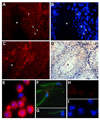Expression of EGFL7 in primordial germ cells and in adult ovaries and testes
- PMID: 18556249
- PMCID: PMC2569197
- DOI: 10.1016/j.gep.2008.05.001
Expression of EGFL7 in primordial germ cells and in adult ovaries and testes
Abstract
We have previously reported the isolation and characterization of a novel endothelial-restricted gene, Egfl7, that encodes a secreted protein of about 30-kDa. We and others demonstrated that Egfl7 is highly expressed by endothelial cells during embryonic development and becomes down-regulated in the adult vasculature. In the present paper, we show that during mouse embryonic development, Egfl7 is also expressed by primordial germ cells (PGC). Expression is down-regulated when PGCs differentiate into pro-spermatogonia and oogonia, and by 15.5 dpc Egfl7 can no longer be detected in the germ line of both sexes. Notably, Egfl7 is again transiently up-regulated in germ cells of the adult testis. In contrast, expression in the ovary remains limited to the vascular endothelium. Our results provide the first evidence of a non-endothelial expression of EGFL7 and suggest distinctive roles for Egfl7 in vascular development and germ cell differentiation.
Figures








Similar articles
-
EGFL7: a unique angiogenic signaling factor in vascular development and disease.Blood. 2012 Feb 9;119(6):1345-52. doi: 10.1182/blood-2011-10-322446. Epub 2011 Dec 7. Blood. 2012. PMID: 22160377 Free PMC article. Review.
-
Novel expression of EGFL7 in placental trophoblast and endothelial cells and its implication in preeclampsia.Mech Dev. 2014 Aug;133:163-76. doi: 10.1016/j.mod.2014.04.001. Epub 2014 Apr 19. Mech Dev. 2014. PMID: 24751645 Free PMC article.
-
Epidermal growth factor-like domain 7 is a marker of the endothelial lineage and active angiogenesis.Genesis. 2014 Jul;52(7):657-70. doi: 10.1002/dvg.22781. Epub 2014 May 2. Genesis. 2014. PMID: 24740971 Free PMC article.
-
Nanog expression in mouse germ cell development.Gene Expr Patterns. 2005 Jun;5(5):639-46. doi: 10.1016/j.modgep.2005.03.001. Epub 2005 Apr 9. Gene Expr Patterns. 2005. PMID: 15939376
-
In or out stemness: comparing growth factor signalling in mouse embryonic stem cells and primordial germ cells.Curr Stem Cell Res Ther. 2009 May;4(2):87-97. doi: 10.2174/157488809788167391. Curr Stem Cell Res Ther. 2009. PMID: 19442193 Review.
Cited by
-
Altered feto-placental vascularization, feto-placental malperfusion and fetal growth restriction in mice with Egfl7 loss of function.Development. 2017 Jul 1;144(13):2469-2479. doi: 10.1242/dev.147025. Epub 2017 May 19. Development. 2017. PMID: 28526753 Free PMC article.
-
EGFL7: a unique angiogenic signaling factor in vascular development and disease.Blood. 2012 Feb 9;119(6):1345-52. doi: 10.1182/blood-2011-10-322446. Epub 2011 Dec 7. Blood. 2012. PMID: 22160377 Free PMC article. Review.
-
Circulating EGFL7 distinguishes between IUGR and PE: an observational case-control study.Sci Rep. 2021 Sep 9;11(1):17919. doi: 10.1038/s41598-021-97482-2. Sci Rep. 2021. PMID: 34504270 Free PMC article.
-
A role for Egfl7 during endothelial organization in the embryoid body model system.J Angiogenes Res. 2010 Feb 19;2:4. doi: 10.1186/2040-2384-2-4. J Angiogenes Res. 2010. PMID: 20298530 Free PMC article.
-
Novel expression of EGFL7 in placental trophoblast and endothelial cells and its implication in preeclampsia.Mech Dev. 2014 Aug;133:163-76. doi: 10.1016/j.mod.2014.04.001. Epub 2014 Apr 19. Mech Dev. 2014. PMID: 24751645 Free PMC article.
References
-
- De Felici M, McLaren A. Isolation of mouse primordial germ cells. Exp. Cell Res. 1982;142:476–482. - PubMed
-
- De Felici M. Cell biology: a laboratory handbook. 2nd ed. Vol I. New York: Academic Press; 1998. Isolation and culture of germ cells from the mouse embryo; pp. 73–85.
-
- De Felici M. Regulation of primordial germ cell development in the mouse. Int. J. Dev. Biol. 44:575–580. - PubMed
-
- Enders GC, May JJ., 2nd Developmentally regulated expression of a mouse germ cell nuclear antigen examined from embryonic day 11 to adult in male and female mice. Dev. Biol. 1994;63:331–340. - PubMed
Publication types
MeSH terms
Substances
Grants and funding
LinkOut - more resources
Full Text Sources
Molecular Biology Databases

